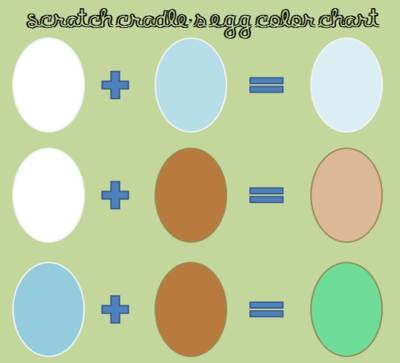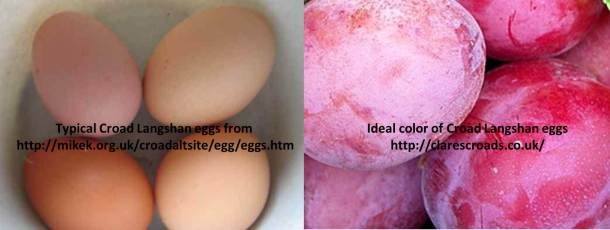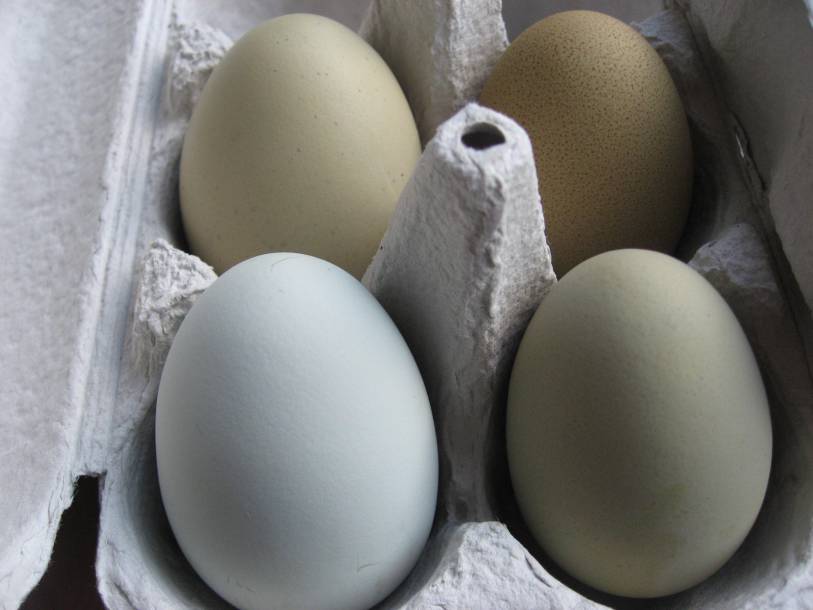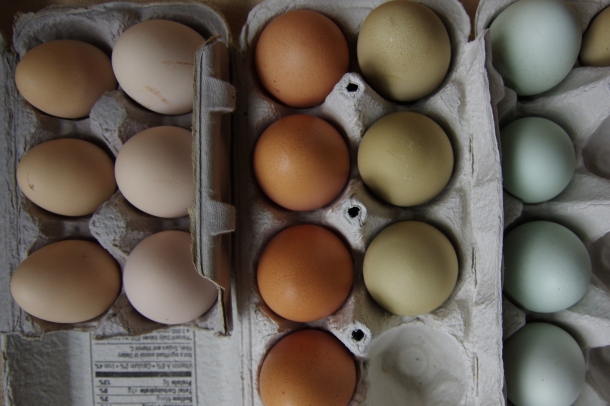In the first article of the Genetics Mini-Series, I discussed the genes responsible for egg shell color, the compounds which are involved in producing those colors, and how those colors behave during the egg laying cycle. In the second article on egg shell color, I discussed basic autosomal dominance and breeding for blue egg color. This week, I will briefly review how to obtain other egg colors.
Genetics of Egg Shell Color Part 3: Breeding For Other Egg Colors
Genetics Mini-Series Article #3
The most simplified, and thus not-entirely-accurate, explanation of egg color breeding appears in the chart above. Blue egg shells (O) are dominant over white egg shells (o). The brown outer coating is governed by at least 13 genes, and so the generation resulting from a cross will lay eggs with an intermediate level of darkness. Additionally, some breeds have a gene which can inhibit (lessen or block entirely) the expression of brown pigment, such as pr, a recessive sex-linked gene.1, 2 I discussed this and the basics of egg color in the first article of the Genetics Mini-Series.
White Egg Shells (o, wild type)
White egg shells have no brown pigment over the surface or blue pigment within the shell. However, sometimes even white-egg-layers can lay a slightly brown or tinted egg after a long period of non-laying because of a build-up of the brown pigment, protoporphyrin which is derived from hemoglobin or blood, within their reproductive tract.
Pink, Plum, Purple, and Gray
Current research acknowledges only two base shell colors: white and blue. However, pink eggs are common among Easter Eggers, purple or lavender eggs sometimes result from barnyard crosses, and Croad Langshans lay plum colored eggs. While it may be that a pink pigment can permeate the shell (see this forum discussion), pink coloring usually results from the bloom or cuticle which is a protein-like mucous coating applied by the hen’s reproductive tract just before the egg is laid which protects the egg from bacteria.3, 4 (This is why it is best not to wash clean eggs; washing removes the protective cuticle.)
This cuticle, when applied over a white egg shell, creates a pink-colored egg. Just as thicker layers of protoporphyrin result in a darker brown egg, thicker layers of bloom result in a darker plum-colored egg as in that of the Croad Langshan (a breed which was actually used in the development of the Marans.) Gray appears to be the result of a thick layer of bloom over a blue or green egg, as you can see in the photo on the third page of forum thread above.
Green and Olive
Many people love the dark green eggs. Some breeders are crossing dark brown egg layers and blue egg layers to create what is termed “olive eggers.” These mixed-breed chickens carry blue egg genes, often accompanied by pea combs, and the genetics for thick, dark brown coating. This cross is most successfully accomplished with Ameraucana blue layers from a line with the emphasis on egg color more than conformation and a Marans rooster from a dark-egg laying line. The initial cross is usually not as dark as breeders would like, so you often see the F1 (offspring of the initial cross, first filial generation) pullets being bred back to their Marans father to darken the eggs of the F2 generation. As was discussed in the previous GMS post, if the blue egg layer is heterozygous (Oo), then some offspring will not inherit the blue-egg laying gene needed under the brown to make green. Selecting offspring with pea combs is a good way to increase the chances of selecting those with the blue-egg gene.
Some breeders are trying to make true breeding olive eggers which will have a consistent shape, look, and egg color from generation to generation. Some lines are barred with beards such as these from Froggy Bog Farm. This can be accomplished by crossing Cuckoo Marans with a solid colored Ameraucana, usually black to support the barring. If you use Cuckoo Marans hens with a black Ameraucana rooster, your first generation would be sex-linkedand all of the male offspring would be barred and have a white dot on their heads as chicks. (I’ll explain sex-linkage in the next post.) If you use black Ameraucana hens with a Cuckoo Marans rooster then it would be easy to breed back the daughters to their father to further darken the eggs. The F1 generation would not be sex-linked; all of the chicks would be barred and have a white dot on their heads. Other breeders are using wheaten Ameraucanas crossed with wheaten Marans or wheaten Penedescencas to create wheaten olive eggers such as these at White Mountains Ranch. However, these layers relatively dark eggs are of a medium brown tone.
These past three weeks have been a basic primer in genetics focusing on egg color. In the upcoming weeks, I will address sex-linkage, shank color, and explain a bit about DNA and chromosomes.

![By John Atherton (Chicken eggs, Loma area, Liberia, 1968) [CC-BY-SA-2.0 (http://creativecommons.org/licenses/by-sa/2.0)], via Wikimedia Commons](https://i0.wp.com/upload.wikimedia.org/wikipedia/commons/8/8b/Liberia_-_Chicken_eggs_in_Loma.jpg)
![By Will Merydith from Fairfield, Iowa, USA (Natural Easter Colored Eggs) [CC-BY-SA-2.0 (http://creativecommons.org/licenses/by-sa/2.0)], via Wikimedia Commons](https://i0.wp.com/upload.wikimedia.org/wikipedia/commons/1/1c/Natural_Easter_Colored_Eggs.jpg)


![By Rob and Stephanie Levy from Townsville, Australia [CC-BY-2.0 (http://creativecommons.org/licenses/by/2.0)], via Wikimedia Commons](https://i0.wp.com/upload.wikimedia.org/wikipedia/commons/8/82/Easter_Egger_hen_pair.jpg)






Keep it up! It’s fascinating!!
Very readable, very understandable posts. I finally truly understand F-1 and F-2. Thanks and please keep it up.
I didn’t even think of breeding for egg color, but why not right?! Fascinating!
This is great reading! And I must say I really want a nest basket just like the one in the photo!
Do you mean the basket in the white-egg photo? I know – it is so cool! Someone should start making one here in the US. I would buy one! That picture is from Wikimedia Commons and was taken in Loma, Liberia!
Yes, that one! I would buy one too. Maybe I can make it next summer’s crazy project.
I found your blog after someone mentioned the genetics mini series on the Basque thread (and I thought, “what genetic mini series?”). I am Buckabucka. I can’t wait to read the rest.
Oh, awesome! I know you! 😀 It would be a great project. I think I would probably brush it off and set it in the sun every few months or soak it in a tub of Oxine water or something just to keep down the pests. I bet the people who made the Sudanese basket just make fresh ones every now and then. Let me know if you do make them – I’ll order one!
Hmmm, didn’t even think about bugs! Now I’m thinking maybe I could lash together some cornstalks that I have out there.
This is exactly the kind of thing that always happens to me…. I am working full-time, busy with the garden and chickens, but will waste an entire weekend trying to lash together cornstalks (and inevitably fail) : )
I love it! You’ll have to post some pictures on the Basque thread if you try it!
Crazy-looking teepee-style nest box completed! I will post photos on the Basque thread as soon as I have time to take some and get on the real computer. It was a fun project.
Awesome! I can’t believe you made one already. I can’t wait to see it!
What a wonderful explanation of the genetics of eggshell color, a much misunderstood topic indeed. Thank you for linking up at the Clever Chicks Blog Hop this week and I hope we hear more from you next week!
Cheers,
Kathy
The Chicken Chick
Thank you! I’ve enjoyed reading everyone’s posts!
Great article and fascinating topic! I love the idea of having a wide variety of color in my egg basket and genetics has always been a topic of interest for me. So you’ve certainly grabbed my attention and I’m off to read your other articles in this genetics series 🙂
That’s great to hear! It was such fun to write. Genetics can be really technical and thick, but I tried to keep it light and practical. I hope you enjoy!
Really interesting!! We get some blue and green. I love them. Thanks for linking up this week at the Backyard Farming Connection Hop – hope to see you next week 🙂
Thank you for hosting! It was certainly fun, and I will be back.
This is so interesting — I never thought about attempting to cross for egg color. That last photo is gorgeous. Thank you for sharing at Rural Thursdays!
Thank you, and thank you for hosting! The first three posts or so of the genetics mini-series discuss egg color if you ever wanted to try it.
QUESTION? What happens when you cross BLUE + GREEN egg layers? Various shade of ? Will there always be a green tint? Thanks.
It’s a bit unpredictable because there are so many genes involved with that brown coating. I would expect shades of green, but you might be able to get some without the coating. Just luck of the draw as far as what you’re starting with. I know it’s been difficult for the Ameraucana breeders to get rid of the green which leads me to think it’s a pretty persistent trait.
Pingback: Gorgeously Hued Eggs – NO DYE! at Bunchland
Could you label all of the lovely eggs?
I am curious, I have a blue Ameraucana rooster, and my hens are faverolle, golden buff, black australorp, barred rock, rhode island red, and buff orpington. Will they produce olive eggers, or will it be hit and miss?